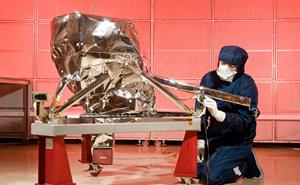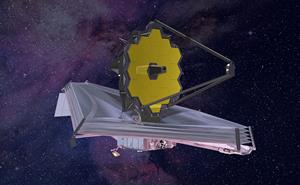At 12.20pm GMT today the telescope, known as just 'Webb', blasted off from the Arianespace spaceport in French Guiana - the culmination of decades of scientific collaboration.
The mission is led by NASA, the European Space Agency (ESA) and the Canadian Space Agency, with the UK playing a major role by leading the European Consortium which, partnered with US institutes, designed, built and tested one of the four main science instruments.
Science Minister George Freeman said:
“Today is a monumental milestone for international and UK space science: the Webb Space Telescope will allow us to go further and deeper to explore and discover our planetary universe.
“The project draws heavily on the world-class expertise of top UK scientists and engineers who were able to deliver vital pieces of this complex and powerful telescope.
“Being at the heart of this international project showcases the innovative talent of the UK's world-leading scientists and engineers, and emphasises our position as a global science powerhouse."
Seeing the universe
The telescope is set to redefine our understanding of the cosmos and unveil some of the secrets of the distant universe.
Webb will peer through dusty clouds in space to allow scientists to determine how the first galaxies were formed and will see our own solar system in whole new ways and in never-before-seen detail.
Scientists, engineers and technicians in the UK were crucial to the development and launch of the Mid-Infrared Instrument (MIRI), which will be able to see the faint light from the most distant stars, effectively looking further back in time than ever before, and to peer through dust and gas to spot stars being born.
The MIRI development has been funded by the UK Space Agency and the Science and Technology Facilities Council, part of UK Research and Innovation, and ESA.
Caroline Harper, Head of Space Science at the UK Space Agency, said: “Webb is set to re-write the text books on astronomy, showing us things about the universe we have never been able to see before. I am excited to see the fascinating discoveries the spacecraft makes as it reveals the evolution of the universe.
“The UK has played a crucial role in this once-in-a-generation mission, developing the Mid-Infrared Instrument, which will examine the physical and chemical properties of objects in the early universe in greater detail than ever. This has been a fantastic example of academic-industry partnership, showcasing the skills and expertise of our scientists and engineers."

MIRI at RAL Space. Credit: STFC RAL Space
Webb in the UK
MIRI will deliver a host of capabilities, boasting a spectrograph to break up light into its constituent wavelengths, a coronagraph to block starlight and look at fainter objects next to stars, and a camera to take pictures.
MIRI was designed, built, and tested by a European Consortium of 10 member countries led by the UK, in partnership with the US. The European contribution is led by Professor Gillian Wright MBE of STFC's UK Astronomy Technology Centre (UKATC), and includes STFC RAL Space, University of Leicester, and Airbus UK.
The UK's lead role in the instrument involves taking responsibility for the overall design, science performance, and the mechanical, thermal and optical design, along with the assembly, integration, testing and calibration software.
Professor Gillian Wright, European Principal Investigator for MIRI and Director of UKATC, said: “To see Webb launch, with MIRI on board, after more than two decades is a seminal moment.
“MIRI is a special instrument, for the breadth of its science, the team that built it, and being the coolest instrument on Webb. The MIRI team rose to the challenges and brought some exquisite engineering solutions to make it a reality. The Webb mission as a whole is an amazing technological breakthrough in scale and complexity, and this extends to the instruments, including MIRI. With the launch, all of us are excitedly anticipating the first MIRI data and the new view of the universe we will have."
What's next for Webb
Although Webb has successfully launched, its journey is only just beginning.
The giant mirror for the telescope had to be launched as 18 segments folded inside the launch vehicle and it must be unfolded, and all the segments perfectly aligned, in space. A huge sunshield the size of a tennis court is needed to keep the instruments cold enough to work and this must also be unfurled in space.
Webb will then go on a month-long journey to its destination, a million miles from Earth. In the six months after launch, the observatory commissioning will take place – with first results expected in the summer of 2022.
Tim Grundy, Instrument Scientist and RAL Space MIRI project lead said:
“It is a once in a generation opportunity for anyone involved in the space sector to work on a project at the scale and complexity of the Webb Telescope. After almost two decades of hard work and thousands of hours of testing MIRI, here at RAL Space and in the USA, it is exciting to begin the next stage of the mission. The whole team is now looking forward to the new discoveries and insights that Webb will bring.”

Artists impressions of the Webb Telescope. Credit: Northrup Grumman
More about MIRI
The roles shared between the UK institutions in the MIRI partnership as follows:
- UK Astronomy Technology Centre (UKATC) - Overall science lead for the European consortium; leadership of the overall design, the end-endoptical design modelling, interfaces and analysis, providing the spectrometer pre-optics subsystem and calibration modules and leading the post-delivery testing and the commissioning.
- STFC RAL Space - Responsible for overall instrument thermal design and analysis and production of all thermal hardware; assembly, integration, testing & verification of instrument including provision of necessary bespoke test facilities; initial calibration; consortium contamination control leadership role.
- University of Leicester - Responsible for instrument overall mechanical design and analysis; provision of instrument primary structure (in partnership with DTU Space); provision of mechanical ground support equipment.
- EADS Astrium (now known as Airbus) - Overall project management and engineering leadership role; systems engineering; overall instrument product assurance leadership.
The International MIRI team
MIRI was developed as a 50-50 partnership between Europe and the USA. JPL leads the US efforts for MIRI with George Reike, University of Arizona as the science lead. The MIRI cryocooler development was led and managed by JPL, in collaboration with NASA’s Goddard Space Flight Center in Greenbelt, Maryland, and Northrop Grumman Aerospace Systems in Redondo Beach, California. The focal plane systems (detectors and signal chain electronics) were also provided by JPL. Sweden and Ireland provided filters and dichroics, the MIRI imager optical system and coronagraphs were developed in France, DTUSpace provided the primary structure carbon fibre hexapods, the spectrometer main optics and gratings were provided by the Netherlands, the contamination control cover and its mechanism was developed in Switzerland, the input optics and calibration subsystem and mechanism control electronics in Belgium, the wheel mechanisms for both the imager and spectrometer were developed in Germany along with leadership of the electrical design and Spain provided the telescope simulator used to test the instrument science performance at RAL Space.
More about Webb in the UK
The MIRI team is not the only contribution made by the UK to Webb. Two senior academics were appointed by ESA to the NIRSpec Science Team and will have major roles in the early science with this ESA provided instrument. Several UK universities and companies were awarded subcontracts for development of critical components through ESA, NASA and the lead MIRI institutes.
